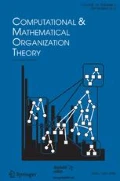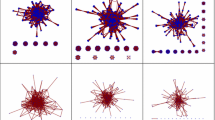Abstract
We consider the bipartite graph of German corporate boards and identify a small core of directors who are highly central in the entire network while being densely connected among themselves. To identify the core, we compare the actual number of board memberships to a random benchmark, focusing on deviations from the benchmark that span several orders of magnitude. The board appointment decisions of largely capitalized companies appear to be the driving force behind the existence of a core in Germany’s corporate network.
Similar content being viewed by others
References
Abe N, Shimizutani S (2007) Employment policy and corporate governance: An empirical comparison of the stakeholder and the profit-maximization model. J Comp Econ 35:346–368
Alfarano S, Milaković M (2009) Network structure and N-dependence in agent-based herding models. J Econ Dyn Control 33:78–92
Battiston S, Catanzaro M (2004) Statistical properties of corporate board and director networks. Eur Phys J B 38:345–352
Bonacich P (1972) Factoring and weighting approaches to status scores and clique identification. J Math Soc 2:113–120
Boone AL, Field LC, Karpoff JM, Raheja CG (2007) The determinants of corporate board size and composition: An empirical analysis. J Financ Econ 85:66–101
Borgatti SP (2006) Identifying sets of key players in a social network. Comput Math Organ Theory 12:21–34
Borgatti SP, Everett MG (1999) Models of core/periphery structures. Soc Netw 21:375–395
Borgatti SP, Foster PC (2003) The network paradigm in organizational research: A review and typology. J Manag 29(6):991–1013
Brass DJ, Galaskiewicz J, Greve HR, Tsai W (2004) Taking stock of networks and organizations: A multilevel perspective. Acad Manag J 47(6):795–817
Caldarelli G, Catanzaro M (2004) The corporate boards networks. Physica A 338:98–106
Conyon MJ, Muldoon MR (2006) The small world of corporate boards. J Bus Fin Account 33(9):1321–1343
Davis GF, Yoo M, Baker WE (2003) The small world of the American corporate elite, 1982–2001. Strateg Organ 1(3):301–326
Ferris SP, Jagannathan M, Pritchard AC (2003) Too busy to mind the business? monitoring by directors with multiple board appointments. J Finance 58(3):1087–1111
Galaskiewicz J (2007) Has a network theory of organizational behaviour lived up to its promises? Manag Organ Rev 3(1):1–18
Harris IC, Shimizu K (2004) Too busy to serve? an examination of the influence of overboarded directors. J Manag Stud 41(5):775–798
Hermalin BE, Weisbach MS (2003) Boards of directors as an endogenously determined institution: A survey of the economic literature. Econ Policy Rev Fed Reserve Bank of New York 9:7–26
Holme P (2005) Core-periphery organization of complex networks. Phys Rev E 72:046111
Linck JS, Netter JM, Yang T (2008) The determinants of board structure. J Financ Econ 87:308–328
Lindbeck A, Snower DJ (2001) Insiders versus outsiders. J Econ Perspect 15(1):165–188
Mintz B, Schwartz M (1981) Interlocking directorates and interest group formation. Am Soc Rev 46(6):851–869
Newman MEJ (2002) Assortative mixing in networks. Phys Rev Lett 89(20):208701
Newman MEJ, Strogatz SH, Watts DJ (2001) Random graphs with arbitrary degree distributions and their applications. Phys Rev E 64:026118
Pagano M, Volpin P (2005) Managers, workers, and corporate control. J Finance 60:841–868
Provan KG, Fish A, Sydow J (2007) Interorganizational networks at the network level: A review of the empirical literature on whole networks. J Manag 33(3):479–516
Raheja CG (2005) Determinants of board size and composition: A theory of corporate boards. J Financ Quant Anal 40(2):283–306
Robins G, Alexander M (2004) Small worlds among interlocking directors: Network structure and distance in bipartite graphs. Comput Math Organ Theory 10:69–94
Seidman SB (1983) Network structure and minimum degree. Soc Netw 5:269–287
Tirole J (2001) Corporate governance. Econometrica 69(1):1–35
Uzzi B, Amaral LAN, Reed-Tsochas F (2007) Small-world networks and management science research: A review. Eur Manag Rev 4:77–91
Williamson IO, Cable DM (2003) Organizational hiring patterns, interfirm network ties, and interorganizational imitation. Acad Manag J 46(3):349–358
Author information
Authors and Affiliations
Corresponding author
Rights and permissions
About this article
Cite this article
Milaković, M., Alfarano, S. & Lux, T. The small core of the German corporate board network. Comput Math Organ Theory 16, 201–215 (2010). https://doi.org/10.1007/s10588-010-9072-4
Published:
Issue Date:
DOI: https://doi.org/10.1007/s10588-010-9072-4




